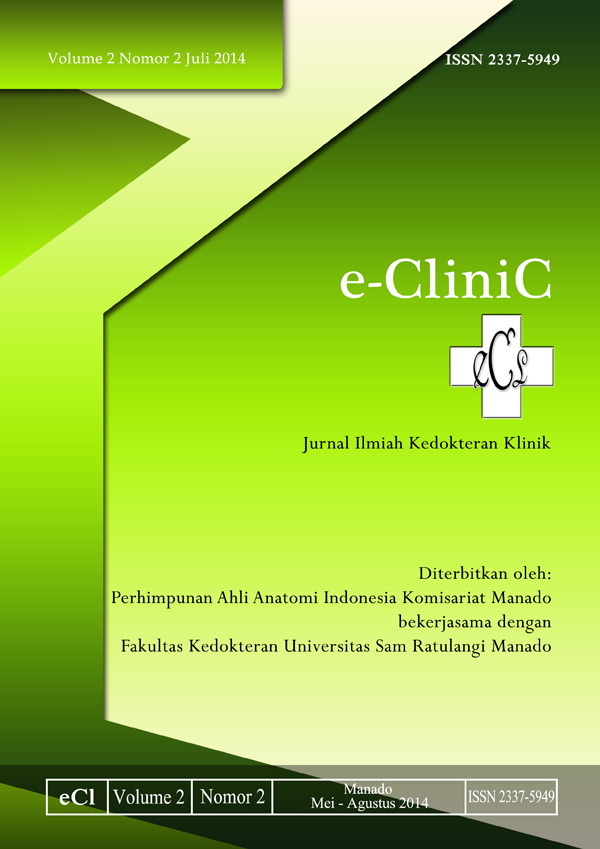KECENDERUNGAN PENDERITA RETINOPATI DIABETIK
DOI:
https://doi.org/10.35790/ecl.v2i2.5099Abstract
Abstract: One of the complications of diabetes is microvascular complications of retinopathy in the eye is that if it continues to be a cause of blindness. The incidence of diabetic retinopathy continues to increase with the increase in people with diabetes with uncontrolled blood sugar. Blindness due to diabetic retinopathy is a health problem that look out world because of blindness will decrease the patient's quality of life and productivity which ultimately led to the social burden to society. The purpose of this study was to determine the tendency of patients with diabetic retinopathy. This is a descriptive study to examine the data of diabetic retinopathy patients in ophthamology community health center. It was found that the number of patients with diabetic retinopathy in 2012 is 34 people and in 2013 amounted to 44 people. An increasing number of people with diabetic retinopathy in 2013 amounted to 10 people or in a precentage of an increase in the number of patients is as much as 29.41%. Number of patients with diabetic retinopathy men in 2012 was 12 and in 2013 to 15 so as to increase by 25% and the number of women in 2012 was 22 and in 2013 was 29, an increase in patients is as much as 31.81%. Based on the group of age, the amount of patients in 2013 in the group of 20-40 years is 2 persons, 41-60 years amounted to 20 people, >60 amounted to 14 people, while in 2013 the number of people in the group of 20-40 years became 3 persons, 41-60 years to 30 people and >60 became 11 people. Increased number of patients with diabetic retinopathy in 2013 with the total of 10 persons and a precentage of 29.41%.
Keywords: diabetic mellitus, diabetic retinopaty.
Â
Â
Abtrak: Salah satu komplikasi dari DM adalah komplikasi mikrovaskuler pada mata yaitu retinopati yang jika terus berlanjut akan menjadi penyebab kebutaan. Angka kejadian retinopati diabetik terus meningkat dengan peningkatan penyandang DM disertai gula darah tidak terkontrol. Kebutaan akibat retinopati diabetik ini menjadi masalah kesehatan yang diwaspadai dunia karena kebutaan akan menurunkan kualitas hidup dan produktivitas penderita yang akhirnya menimbulkan beban sosial bagi masyarakat. Tujuan penelitian ini untuk mengetahui adanya kecenderungan penderita retinopati diabetik. Penelitian ini bersifat deskriptif dengan meneliti data-data penderita retinopati diabetik di Balai Kesehatan Mata Masyarakat. Didapatkan bahwa jumlah penderita pasien retinopati diabetik pada tahun 2012 sebanyak 34 orang dan tahun 2013 berjumlah 44 orang. Peningkatan jumlah penderita retinopati diabetik di tahun 2013 berjumlah 10 orang atau dalam persentase terjadi peningkatan jumlah penderita sebanyak 29,41%. Jumlah penderita retinopati diabetik laki-laki pada tahun 2012 adalah 12 orang dan tahun 2013 menjadi 15 orang sehingga terjadi peningkatan sebanyak 25% dan jumlah perempuan pada tahun 2012 adalah 22 orang dan pada tahun 2013 adalah 29 orang, peningkatan penderita sebanyak 31,81%. Berdasarkan kelompok umur jumlah penderita pada tahun 2012 dengan kelompok umur 20-40 tahun berjumlah 2 orang, 41-60 tahun berjumlah 20 orang, >60 berjumlah 14 orang sedangkan pada tahun 2013 jumlah penderita dengan kelompok umur 20-40 tahun menjadi 3 orang, 41-60 tahun 30 orang dan>60 tahun menjadi 11 orang. Terjadi peningkatan jumlah penderita retinopati diabetik di tahun 2013 dengan jumlah 10 orang dengan presentase 29,41%.
Kata kunci: diabetes melitus, retinopati diabetik.
Downloads
How to Cite
Issue
Section
License
COPYRIGHT
Authors who publish with this journal agree to the following terms:
Authors hold their copyright and grant this journal the privilege of first publication, with the work simultaneously licensed under a Creative Commons Attribution License that permits others to impart the work with an acknowledgment of the work's origin and initial publication by this journal.
Authors can enter into separate or additional contractual arrangements for the non-exclusive distribution of the journal's published version of the work (for example, post it to an institutional repository or publish it in a book), with an acknowledgment of its underlying publication in this journal.
Authors are permitted and encouraged to post their work online (for example, in institutional repositories or on their website) as it can lead to productive exchanges, as well as earlier and greater citation of the published work (See The Effect of Open Access).







